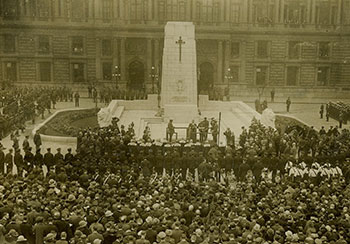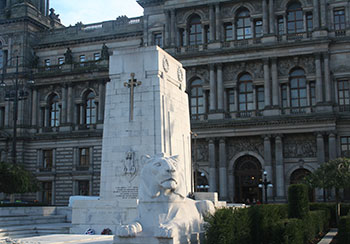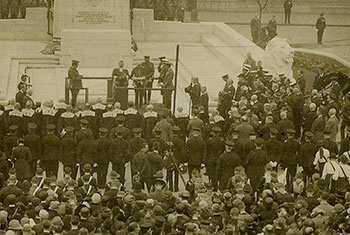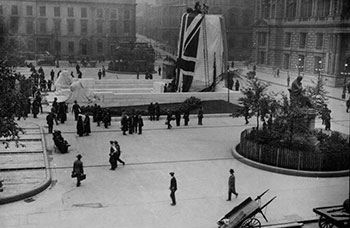Glasgow's Cenotaph
Find out more about the Cenotaph in George Square, Glasgow.
Every year in the centre of Glasgow at George Square, crowds of people gather to remember those who gave their lives in conflicts throughout the last century. This commemoration is focused not just on the remembrance service and its associated silence, but also on the cenotaph located in front of the City Chambers.
Since its unveiling in 1924 people from throughout the city and beyond have congregated at this monument to pay tribute to the fallen. Following four years of war on the 11 November 1918 the armistice was announced spreading celebration and relief throughout the victorious nations - "It was the greatest day of rejoicing Glasgow has ever known".

 however tinged with sadness regarding those men who would never return. A proud city had watched as
however tinged with sadness regarding those men who would never return. A proud city had watched as  one-fifth of its population, over 200,000 men were mobilised during the conflict and of those 18,000 lost
one-fifth of its population, over 200,000 men were mobilised during the conflict and of those 18,000 lost  their lives with approximately a further 34,500 being injured, many seriously.
their lives with approximately a further 34,500 being injured, many seriously.
The scale of this tragedy forged a climate where almost every individual in the country would have been either directly or indirectly affected by the death of a member of the armed forces. A strong desire that there must be some form of commemoration, something through which the memory could live on of those who gave the ultimate sacrifice. This was solidified by the fact that many of the dead were buried in cemeteries in foreign lands which their families couldn't afford to visit or indeed their bodies were never found at all.
Across the nations involved in the Great War monuments from small ones to large national memorials were commissioned. For Glasgow there was a strong desire by the people of the city to have a memorial placed in the city centre. It was suggested that this would provide easy accessibility and create a greater impact as it would be seen by large numbers of people on a daily basis.
With the desire for a fitting tribute clear in Glasgow a war memorial committee was established and chaired by the Lord Provost Sir James Watson Stuart. But for Glasgow it wasn't just about remembering the fallen but helping to retrain those soldiers who had returned to their city injured and without a job.
During a public meeting held on the 13 February 1920 resolutions were passed to proceed with "the erection of a cenotaph of artistic design on a site to be carefully selected" along with support being given to the Prince Albert Memorial Workshops for training of disabled sailors and soldiers.
One week later this new committee met and approved a three step approach as a method of appropriately marking the heroism and sacrifice of the men who lost their lives during the war. First was the commission of a permanent monument in the form of a cenotaph to be placed in George Square. Second was an approach tackling the desire to provide a memorial of utilitarian nature, this involved the maintenance and extension of the Prince Albert Workshops for disabled sailors and soldiers at Killearn Street in Possilpark.
The last aspect of the three steps was to distribute any surplus funds to charities or causes to be chosen at the committee's discretion. The decision selecting George Square as the location for the most obvious physical tribute to the war came from the site's civic importance along with it being a focus for patriotic scenes throughout the conflict.
The Prince Albert Workshops opened by the Prince in 1919. They operated for four years offering training in a range of skills from French polishing, to carpentry and boot making.
A visitor in January 1921 noted that 120 servicemen had been trained successfully and the workshops finally closed in May 1923. This came as training facilities began to be consolidated in larger sites elsewhere, with the building becoming a factory and later demolished for the construction of new flats.
Images:
- Official unveiling of the Cenotaph in Glasgow in 1924 (Copyright Herald and Times Group)
- Cenotaph, George Square Glasgow 2014 (Copyright GCC)
- Official unveiling of the Cenotaph in Glasgow in 1924 - Detail (Copyright Herald and Times Group)
- Final preparations for unveiling of the Cenotaph on Armistice Day 1924 (Copyright Herald and Times Group)
This is an abridged version of a thesis by Colin Blair. This is a pdf of the full version of the thesis called ![]() An Affair of the Soul [23Mb]. We would like to thank Mr Blair for permission to reproduce his work on this website.
An Affair of the Soul [23Mb]. We would like to thank Mr Blair for permission to reproduce his work on this website.











